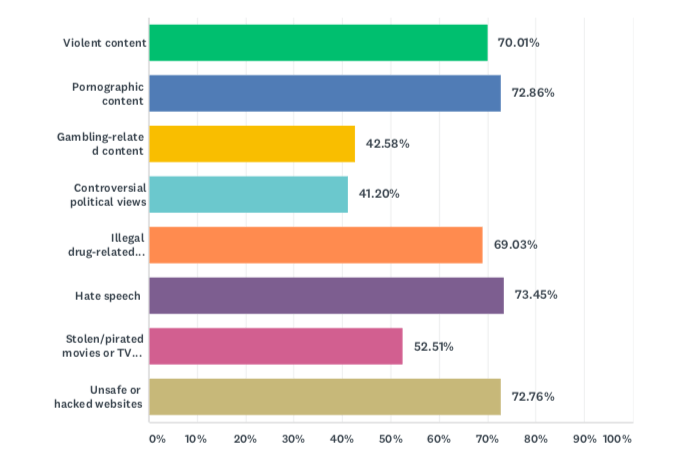Survey: 90% of consumers tell brands to stay away from extreme, offensive content
However, reactions vary by types of content including, terrorism, racism, porn, drugs, gambling, hate speech and politics.
Brand safety issues are partly responsible for the trend toward in-housing and they’re also driving a retreat from programmatic among some brands. A new survey from the Trustworthy Accountability Group (TAG) and Brand Safety Institute (BSI) shows why brands should be nervous about their content appearing beside questionable or offensive content.
Reduce their purchase or stop buying entirely. TAG and BSI polled just over 1,000 U.S. adults in late July. As with other, similar surveys, the parties found that a majority of consumers would have a negative opinion of brands advertising products near extreme or offensive content. And although consumer opinions don’t always translate into action, majorities of consumers told the TAG-BSI survey that they would reduce or stop buying products that appeared in these questionable contexts.
The survey asked respondents to estimate the amount of online content that falls into categories of “dangerous, offensive or inappropriate.” Roughly 85% said some (51%) or a great deal (34%). The survey then asked about reactions to specific types of content.
Which of the following types of content do you think advertisers should prevent their ads from running near?

Politics, gambling and pirated content (movies/TV) were less problematic for respondents than categories such as violence, pornography, Illegal drugs, hate speech or unsafe sites (e.g., malware infected). Overall, 90% said that it was very or somewhat important for advertisers to ensure their ads aren’t on these types of sites.
Many people more disturbed by malware than Nazis. In the context of specific content categories, I was surprised by some of the results. For example, 58% of consumers would stop buying products if they appeared “next to racist neo-Nazi propaganda,” but nearly 67% would do the same for “terrorist recruiting videos.” In other words, some people are more comfortable with racist/Nazi content than terrorist videos.
But the strongest “stop buying” reaction came in response to the question, “If you discovered an ad for a consumer product you regularly buy had infected your computer or mobile device with a virus, how much would you reduce your purchases of that product?” In that case 73% said they would stop buying the product.
Asked which parties in the ecosystem are responsible for policing ads and content, survey respondents basically said “all of the above”:
- Advertiser — 70%
- Ad agency — 68%
- Site owner — 61%
- Technology providers (undefined) — 46%
One might assume that “ordinary consumers” would be ignorant of the backstage workings of the digital ecosystem. So the 68% who said that agencies were partly responsible to police ad placements is a bit of a surprise (perhaps there were lots of Mad Men fans among the respondents).
Finally, one needs to recognize that there’s some room for brand error here — because of the gap between opinions and behavior. Consumers care about patterns and conduct over time generally speaking. But there’s no question brands should do everything they can to minimize their ad exposures to offensive or extreme content.
Why we should care. YouTube is one of the highest profile sites that has been plagued by ongoing brand safety issues and advertiser defections. And while brand safety on YouTube and elsewhere across the internet have improved, it will remain an issue as long as algorithms and machine learning (and not humans) determine when and where to serve ads.
Whitelists, blacklists, direct buying, in-house brand safety positions and concerted industry initiatives will continue to improve online brand safety. Yet the continuing quest for brand safety will come, to some degree, at the expense of audience reach.
(15)



